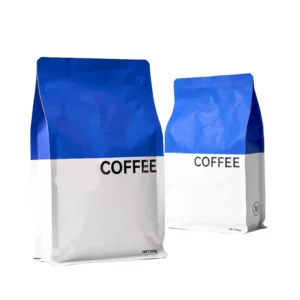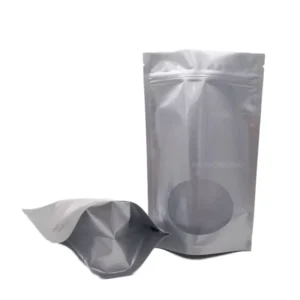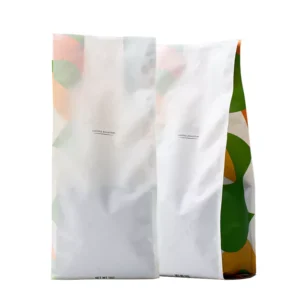When you buy coffee, the coffee bag size matters a lot. It affects freshness, ease of use, and storage space. A good-sized Coffee Kraft Paper Bag keeps your coffee tasty and smelling great.
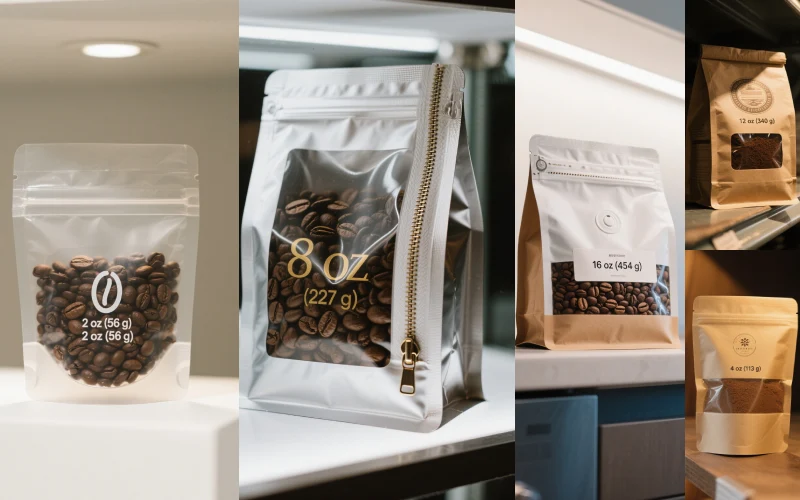
Whether you pick a Coffee Kraft Paper Bag or another type, the right size helps keep it fresh. Coffee packaging materials also protect beans from air and moisture. Custom Coffee Bags and other coffee packaging solutions let you choose what works best for you.
Why Pay Attention to Standard Coffee Bag Size?
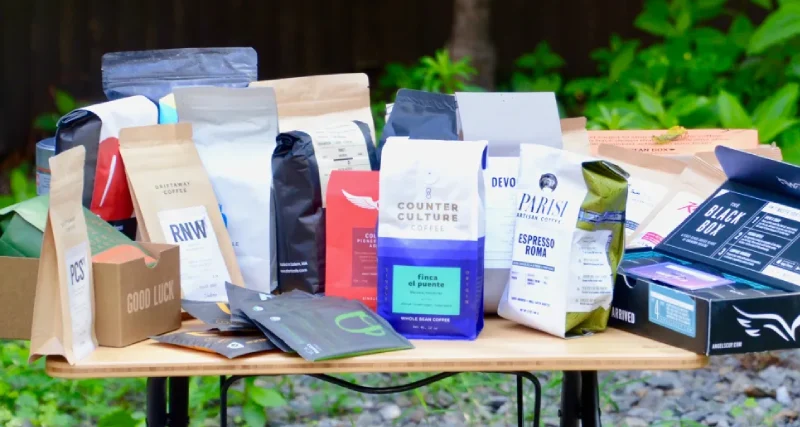
For coffee lovers
Pick a coffee bag size that fits how much you drink. Small bags like 8oz or 12oz work for occasional drinkers. Bigger bags like 1lb or 5lb are better for daily coffee fans.
Store coffee in airtight containers to keep it fresh. Good storage stops it from going stale and keeps the taste, especially for big bags.
Try sampler coffee bags to test new flavors. These small bags let you try blends without buying a lot.
Buying large bags can save money over time. Big bags cost less per ounce, which is great for regular coffee drinkers or businesses.
Look for eco-friendly packaging to help the planet. Many brands now use materials that cut waste and keep coffee fresh.
For coffee bag wholesalers or coffee shop owners
Better Shelf Fit:
Standard coffee bag sizes (like 250g, 500g, or 1kg) are designed to fit neatly on shelves and displays. This makes it easier to stack, store, and showcase your coffee in retail shops or behind the counter.
Easier Packaging Process:
When bags are uniform, it speeds up the packing process. Whether you pack by hand or machine, using standard sizes helps reduce errors and save time.
Clear Communication with Customers:
Customers often look for coffee in familiar sizes. A standard-sized bag helps them know what they’re buying, making it easier to compare prices or try new blends.
Shipping and Storage Efficiency:
Standard sizes mean boxes, cartons, and storage bins can be packed tightly, reducing wasted space and lowering shipping costs—big savings over time.
Professional Branding:
Consistent bag sizes give your brand a polished, reliable look. It’s easier to design labels and apply branding that fits perfectly every time.
Common Standard Coffee Bag Sizes
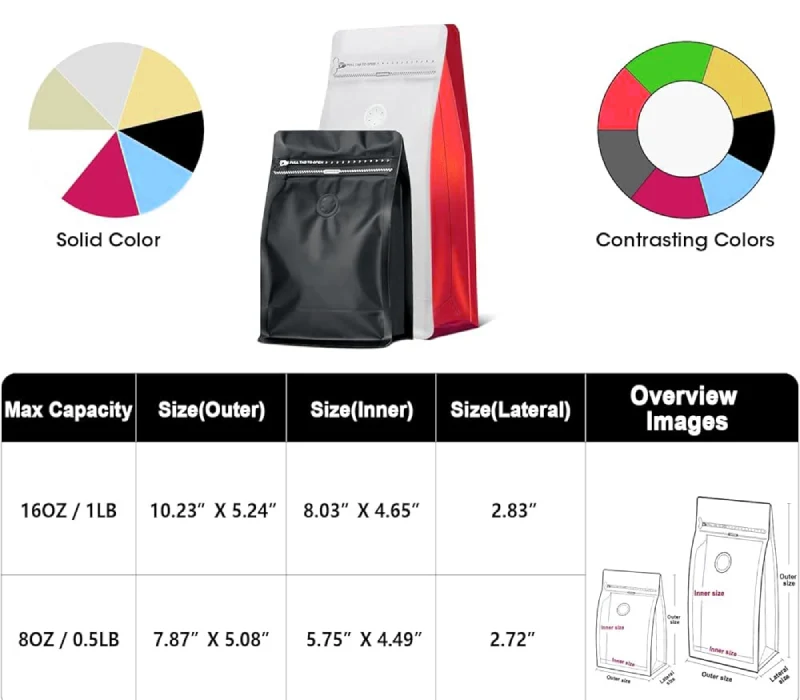
Coffee bags come in many sizes for different needs. Whether you brew for yourself, family, or a busy café, knowing these sizes helps you decide. Let’s look at the most common ones.
8oz and 12oz coffee bag size
The 8oz and 12oz bags are very popular. They’re great for small households or people who love fresh coffee. The 8oz bag, about 227 grams, is ideal for trying new blends or single-origin coffees. The 12oz bag, holding around 340 grams, is a favorite in North America. It offers a good mix of price and amount, perfect for regular use.
Here’s a simple comparison of these sizes:
| Size | Weight | Common Uses |
|---|---|---|
| 8 oz | 227g | Specialty coffees, sample sizes |
| 12 oz | 340g | Popular retail size in North America |
| 16 oz | 454g | This size is ideal for weekly use or small-batch roasting businesses. |
If you like trying new flavors or want smaller amounts, these sizes are great.
16oz and 1lb coffee bag size
For daily coffee drinkers or sharers, the 16oz (1lb) bag is a smart pick. This size, about 454 grams, is common in homes and small offices. It lasts one to two weeks, depending on how much you drink. Many blends and roasts come in this size because it’s convenient and affordable.
A 1lb bag means fewer store trips and steady coffee supply. If you have a favorite roast, this size works well. To keep it fresh, store it in an airtight container away from heat and light.
Bulk coffee bag sizes (2lb, 5lb, and beyond)
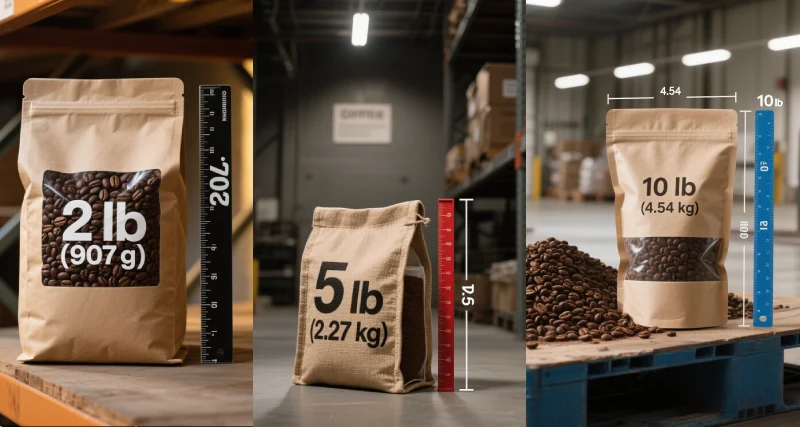
Bulk sizes like 2lb (907g) and 5lb (2.27kg) are for heavy coffee drinkers or businesses. These sizes are common in cafés, offices, and restaurants with high coffee use. Buying bulk often lowers the cost per ounce, saving money for those needing more coffee.
Think about storage if you choose bulk sizes. Coffee stays fresh in smaller airtight containers. Split a 5lb bag into portions to keep its flavor. Bulk bags are also great for events or gatherings with lots of coffee drinkers.
Sampler coffee bag sizes
Sampler coffee bags are great for trying new coffee blends. They usually hold 2oz to 4oz of coffee. This makes them perfect for tasting different flavors or origins. If you like variety, sampler bags are a smart choice.
Why choose sampler sizes?
These small bags let you test coffee without spending too much. You can try several types and find your favorite. They also make thoughtful gifts for coffee lovers. Share unique blends with friends or family to introduce them to new tastes.
Who benefits from sampler coffee bag sizes?
Sampler bags are ideal for curious coffee drinkers who love variety. They’re helpful for people new to specialty coffee to learn about flavors. Small households with limited coffee use also benefit. Cafés and roasters use sampler bags to show their coffee to customers.
How to make the most of sampler sizes?
Keep sampler bags fresh by storing them in airtight containers. Brew them soon to enjoy the best flavor. If you find a coffee you love, buy a bigger bag next time. These small bags are also handy for travel—pack a few for good coffee anywhere.
Sampler coffee bags are convenient and fun. They’re perfect for exploring new coffee options.
Coffee Bag Size Market Differences
U.S. Market: 12 oz and 16 oz are dominant, aligning with local consumption habits;
European Market: Metric sizes like 250 g (≈8.8 oz) and 500 g (≈1.1 lb) are more common;
Japanese Market: Smaller sizes like 100 g and 200 g are preferred, fitting the trend of refined consumption.
Uses and benefits of each coffee bag size
Personal use and small households
Smaller bags like 8 oz and 12 oz are great for homes. They keep coffee fresh and prevent it from going stale. The 8 oz bag is perfect for trying special blends or unique flavors. It’s ideal for those who enjoy exploring new coffee options. The 12 oz bag is the most popular size in stores. It offers enough coffee for regular drinkers to last about one or two weeks.
Families and shared spaces
Medium-sized bags like 1 lb are best for families or shared spaces. This size is easy to find in stores and works well for daily brewing. It provides enough coffee for multiple people without needing frequent refills. If your family loves coffee, this size ensures everyone gets their share without running out quickly.
| Size | Common Use |
|---|---|
| 8 oz | Great for trying specialty blends |
| 12 oz | Popular size for regular drinkers |
| 1 lb | Perfect for families and shared spaces |
Cafes, offices, and businesses
Big bags like 5 lb or 2 kg are ideal for cafes and offices. These sizes are cost-effective for places with high coffee use. Buying in bulk lowers the price per ounce, saving money. Bulk bags are also useful for events or workplaces where coffee is made all day.
Businesses can also use custom coffee packaging for branding. This helps keep coffee fresh while promoting their brand. Whether for a café or office, picking the right bag size makes operations smoother and keeps customers happy.
Trying new coffee with sampler sizes
Sampler coffee bags are a fun way to try new flavors. These small bags, usually 2oz to 4oz, let you test coffee without buying a lot. If you like variety or want to find a new favorite, these are a great option.
You can use them to taste coffee from different places. For example, try a fruity Ethiopian coffee one day and a nutty Brazilian one the next. This helps you see how where coffee is grown changes its flavor. You can also learn about light, medium, and dark roasts and how they taste.
Sampler bags are helpful if you brew coffee in different ways. Some coffees taste better in a French press, while others are great for espresso. Testing small amounts helps you find the best coffee for your method.
These small bags also make great gifts. Share them with friends or family to introduce them to specialty coffee. They’re a thoughtful way to surprise a coffee lover.
Using sampler sizes is a simple way to learn more about coffee. These small bags let you explore new options without spending too much.
Finding the right sized coffee bags: Factors to consider
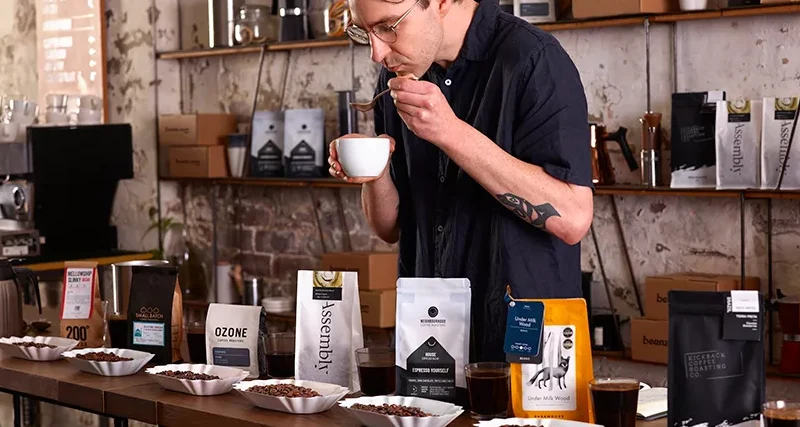
Consumption habits and freshness
How much coffee you drink affects the bag size you need. If you drink coffee every day, bigger bags like 1lb or 2lb are better. For occasional drinkers, smaller bags like 8oz or 12oz work well. Smaller bags keep your coffee fresh and prevent it from going stale.
Fresh coffee tastes the best. Special packaging, like nitrogen flushing, keeps coffee fresh longer. This method slows down oxidation, protecting the flavor and smell of your coffee.
Here’s a simple table about freshness and habits:
| Evidence | Description |
|---|---|
| Freshness Preservation | Nitrogen flushing keeps coffee fresh by slowing oxidation. |
| Consumer Preferences | People want quality and convenience when choosing bag sizes. |
Coffee is more than just a drink. Many enjoy it for its taste and daily routine. Some avoid it due to health concerns or dislike of the flavor. Knowing your habits helps you pick the right coffee bag size.
Storage considerations
Where you store coffee affects how fresh it stays. Keep coffee in a cool, dry place, away from sunlight and moisture. Use airtight containers to protect it from air, which can ruin the flavor.
If you buy large bags like 5lb, divide them into smaller portions. Store these portions in airtight containers to keep them fresh. Smaller bags, like 8oz or 12oz, are easier to store and take up less space.
Think about your storage space before buying coffee. If your kitchen is small, smaller bags are easier to manage. If you have more room, bulk bags save money and reduce trips to the store.
Budget and cost-effectiveness
Your budget matters when picking a coffee bag size. Bigger bags, like 2lb or 5lb, cost less per ounce. They’re a good choice for frequent coffee drinkers or businesses.
Studies show smaller packaging with new methods, like biochar, can lower costs. This means smaller bags might be a better deal if you’re trying new flavors or don’t drink coffee often.
Buying in bulk saves money over time but needs proper storage to stay fresh. Smaller bags are great for testing flavors without spending too much.
Product Quantity
- Small Bags (2 oz – 4 oz): Ideal for sample sizes, gift packs, or limited-edition roasts.
- Medium Bags (8 oz – 12 oz): Great for retail shelves, single-origin offerings, or everyday use.
- Large Bags (16 oz – 5 lbs): Best suited for bulk buyers, cafés, or subscription customers.
- Know your typical batch size and serving size preferences. For example, 12 oz is the most popular retail size in North America.
Coffee Form
- Whole Beans take up more space than ground coffee due to less compactness.
- Ground Coffee is denser and may require slightly smaller bags for the same weight.
- Always test your actual product volume in different bag sizes before committing to a packaging order.
Packaging Material Thickness
- Thicker materials (multi-layer, foil-lined) offer better protection but may slightly reduce internal space.
- Thinner films provide flexibility but might not be ideal for long shelf life.
- Match the bag size with barrier needs. For example, premium roasts often require high-barrier materials to block oxygen and moisture.
Packaging Style
- Flat Pouch: Best for samples or single servings.
- Stand-up Pouch (Doypack): Great for 8 oz to 16 oz bags; popular on retail shelves.
- Side Gusset Bag: Ideal for 1 lb and up, offers a premium look and more volume.
- Box Bottom Bag: Gives structure and shelf appeal, especially for high-end brands.
- Consider how much air the coffee will release—bags with valves and good expansion capacity are key for whole beans.
Valve or No Valve
- Degassing Valve: Necessary for freshly roasted whole beans to release CO₂ without letting oxygen in.
- No Valve: Fine for pre-ground or nitrogen-flushed packs.
- Adding a valve can affect the overall design space and might slightly influence size selection.
Storage & Shipping Constraints
- Think about how many bags fit in a box or on a pallet.
- Consider weight restrictions for courier or shipping services.
- A compact, well-fitting bag reduces shipping costs and improves shelf efficiency.
Branding & Labeling Needs
- Larger bags provide more surface area for branding, storytelling, and product info.
- Smaller bags offer a more minimalistic, quick-grab appeal.
- Align bag size with your visual identity—are you aiming for premium, sustainable, or functional?
Sustainability Goals
- Smaller bags reduce material use but might increase total packaging over volume sold.
- Compostable or recyclable bags may influence thickness and size options.
- Factor in both eco-impact and consumer expectations if you’re using sustainable materials.
To gain deeper insight into how to choose the right size coffee bags, I interviewed Philippe Schaillee, the CEO of Costa Coffee.
“Choosing the right size ensures customer repurchase frequency and directly impacts the freshness of the coffee,” said Philippe Schaillee.
This perspective highlights the strategic importance of packaging—not just for logistics or presentation, but as a critical part of customer satisfaction and brand loyalty.Trends in coffee bag sizes
Eco-friendly and sustainable packaging
The coffee world now focuses on being eco-friendly. Many brands use materials that are better for the planet. Companies like Savor Brands make bags that can break down or be recycled. This change helps reduce waste and protect nature. They also work on new ideas to make packaging both green and high-quality.
You can help by picking coffee bags made from eco-friendly materials. Some brands teach you how to recycle properly. This makes it easier to care for the planet. These changes not only help the Earth but also keep your coffee fresh and tasty.
Popularity of sampler sizes
Small sampler coffee bags are becoming very popular. They let you try different coffees without buying a big bag. You can taste new flavors or see how a coffee works with your brewing style. For instance, one day you might try a light Ethiopian roast, and the next, a dark Colombian one.
This trend shows people want variety and ease. Drip coffee bags, a type of sampler, are especially loved. They are easy to carry, consistent, and create less waste. If you like trying new coffees, sampler bags are a fun and cheap way to explore.
Bulk buying trends
Big coffee bags, like 2lb or 5lb, are still a top choice. Stores like supermarkets sell the most coffee bags and are growing fast. This growth makes it easier to find bulk coffee options.
Buying in bulk has many perks. It costs less per ounce, saving money for regular coffee drinkers. Bulk buying is also convenient and ensures you have enough coffee. With good storage, you can save money and always have fresh coffee.
Picking the best coffee bag size depends on your habits. Small bags, like 8oz or 12oz, are great for personal use. They’re also good for testing new coffee flavors. Bigger bags, like 1lb or 5lb, are better for families or businesses. These sizes work well if you drink a lot of coffee. Think about freshness, storage space, and your budget before buying. Trying sampler bags is a fun way to taste new coffees. You can find your favorite without buying a big bag. This keeps coffee exciting and lets you enjoy different flavors.
Recommended products
FAQ
How big is a standard coffee bag?
A standard coffee bag typically holds 12 ounces (340 grams) of coffee, which is the most popular retail size in North America. The dimensions vary based on the packaging style, but a flat-bottom 12 oz bag is usually around 5″ x 3″ x 9″. It’s enough to brew roughly 24–36 cups of coffee, depending on how strong you like it.
Why are coffee bags 12 oz?
Coffee bags are often 12 oz due to a combination of consumer convenience and market tradition. It strikes a balance between providing enough coffee for several days and encouraging regular freshness and repurchase. Many artisan and specialty roasters favor this size because it showcases premium blends without overwhelming the buyer with bulk quantities.
How big is a 12 oz bag of coffee?
A 12 oz (340g) bag of coffee usually contains enough ground or whole beans to make 24 to 36 cups, depending on your brew strength and cup size. Physically, the bag might be 5 inches wide, 3 inches deep, and 9 inches tall, especially in stand-up or gusseted pouch formats with a degassing valve.
What size is a coffee sack?
A traditional coffee sack, often used for storing green coffee beans, holds about 60 kilograms (132 pounds). These burlap or jute sacks are commonly used in global coffee trade. Their size is generally 28 to 36 inches wide and 40 to 48 inches tall, depending on origin and exporter specifications.
How much coffee is in a standard bag?
Although a standard cup is equivalent to 8 ounces, in coffee terminology, “a cup of coffee” is sometimes defined as 6 ounces. To simplify the calculations here:
A 12-ounce bag of coffee (the most common size) yields about 32 cups if each mug is filled with 6 ounces of coffee.
If you fill your mug closer to the standard 8 ounces, the same 12-ounce bag will make approximately 21 cups.
Conclusion
Choosing the right coffee bag size is more than just a packaging decision—it’s about delivering the best possible coffee experience to your customers. From preserving freshness to aligning with branding and sustainability goals, standard coffee bag sizes serve a wide range of purposes for individual consumers, retailers, and coffee shop owners alike.
At Bnpack, we specialize in manufacturing high-quality coffee bags that cater to every stage of your business growth—whether you need compact sampler sizes for customer trials or bulk-sized bags for wholesale and café operations. Our packaging solutions are thoughtfully designed with features like resealable zippers, one-way valves, and eco-friendly materials to protect your coffee and support your brand story.
By offering a versatile selection of products such as:
- Biodegradable Stand Up Coffee Pouches With Zipper
- Eco Friendly Coffee Pouches
- Mylar Stand-Up Coffee Pouches With Clear Window
- Side Gusset Coffee Bags with Valve
—we help you meet market demands with confidence, quality, and sustainability in mind.
Let us support your journey in creating coffee packaging that’s not only functional but also memorable. Together, we’ll ensure your coffee stays fresh—and your brand stands out.


